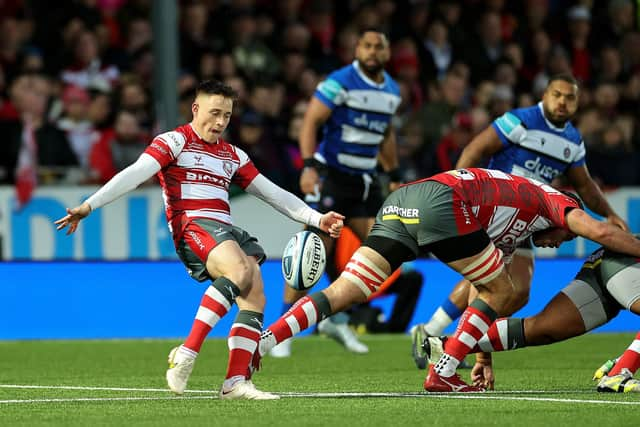Fraser Brown: Bath v Gloucester clip wasn’t pretty but kicking is integral to rugby and can be brilliant if done well


It wasn’t a piece of individual skill or a stunning team try but a rather mind-numbing 12-kick rally which attracted much derision from self-appointed experts on Twitter. For the uninitiated, it looked like two teams mindlessly punting the ball to each other and didn’t paint rugby in a particularly good light. But kicking is, and always has been, a key part of the sport and when done well it can lead to some brilliant passages of play.
The reason the clip has gained so much traction is largely down to social media and I read that whoever originally posted the footage has had five cease and desist letters from copyright people ordering them to take it down.
Advertisement
Hide AdAdvertisement
Hide AdIt sums up rugby’s attitude to social media at the moment. How many highlights packages have you seen on Twitter of the unbelievable games and skills clips from the World Cup? None, because of World Rugby’s insistence that content can’t be shared online by non-rights holders. It’s short-sighted and will endanger the sport’s future if they are not careful.
The Bath-Gloucester footage has sparked a good debate but it’s important to note that what we saw is not particularly new. It was a particularly good (or bad example) of a seemingly endless cycle of kicks, with players clustered in the middle of the pitch as the ball sailed over their heads. But such passages of play have always been permitted by the laws.
If the ball is kicked and you are in an offside position (in front of the kicker) you can’t advance to the ball. You either have to wait until you are played back onside by the kicker or a player in your own team that started behind the ball. Or you can be played onside by the receiving team when they’ve run five metres or passed the ball. So what teams are doing now is gathering in the middle of the pitch and, as the kick goes in, they’re waiting for the catcher to either pass or run five metres, to play them on all onside. Then they can put pressure on the receiving team.
The general trend in rugby over the last five years has been to focus on territory and playing the game as far away from your own tryline as possible. That only works if you’re able to kick long and/or apply pressure higher up the pitch with the kick-chase.
Shaun Edwards was one of the first to pick up on this and France have done it for the last three years. And the person who has probably been the greatest proponent of it is Antoine Dupont. If you watch the France games, he will be 40 metres in front of the rest of the players, and as soon as he gets the trigger he is flying in to put pressure on the receiver. He has done it for the last three years and I’ve sat in countless analysis meetings and no-one has criticised him for doing it. In fact, it’s been quite the opposite. There has been clip after clip and commentators are praising his rugby IQ, describing it as brilliant, intelligent rugby.


But when it goes into a boring kick cycle in a more humdrum setting then suddenly there are calls to change the law. It shows that certain individuals and certain teams skew perceptions of whether it’s a good or a bad thing and whether it’s clever or not.
For the entirety of my playing career, amateur and professional, there have been kick battles and there have been times when the forwards have had to do 20-metre shuttles in the middle of the pitch. From a forwards’ point of view, you just stand still, get your rest, then when the backs have finished kicking bullets to each other you’re all good to go because you’ve had a 20-second breather.
People will say that the clip from Bath v Gloucester made the game look boring. Others will say kicking is an integral part of the sport and if done well it can be brilliant. Both can be true.
Advertisement
Hide AdAdvertisement
Hide AdIf it’s done poorly and often, it becomes boring and when that narrative gets repeated over and over again it tends to stick. But I think there is an onus on our sport to try to explain what is happening. At the weekend, the TNT commentators at the Rec just kept saying it was a boring passage of play rather than explaining what was happening and why it was happening. So this negative narrative emerges when in reality all it takes is one brilliant kick to open up space and the whole game changes. Some of those kicks in the Bath-Gloucester game were about six inches away from being brilliant kicks and would have completely changed the perception.
I don’t think kicking is boring per se. If you kick poorly and kick for the sake of kicking, it’s dull because you are not looking to create space, you are engaging in a kick-battle in the hope that your opponents make a mistake or they get bored before you do.
The other side of the coin is that with a couple of strategic kicks you can edge your way up the field or create a disconnect in the opposition’s chaseline. If you’ve got space in front of you to run, if the back-field can get to their own 10-metre line or over halfway they should take the space, but a lot of the messaging from coaches is, ‘if you get into a kick-battle, don’t get bored, just keep kicking it and wait for your opponent to make a mistake. Don’t lose your patience and try to run the ball and end up getting tackled and losing possession’.
So it’s risk averse but the reality is that kick battles open up space in the back field and in the middle of the pitch and it can come down to whether you’re brave enough or skilful enough to try to exploit that or whether you just want to stay in those long kick-battles.
It comes down to the messaging from the coaches and the mindset of the players. Do they want to kick to create space or kick in the hope their opponents make a mistake?
It goes in cycles and when kicking is of a very high level and is well executed it’s brilliant. The introduction of the 50:22 law has been brilliant, perhaps the single best modification in the professional game. But as a consequence, teams now station more players in the back field because they can’t risk having a 50:22 kick against them. So there are more players to field balls when they are kicked which leads to more kick-battles. It’s cause and effect. You change one thing and it has an effect on another part of the game.
More kicking is not a bad thing. Poor games stem from poor skill execution and a defensive, risk averse mindset.
Comments
Want to join the conversation? Please or to comment on this article.
